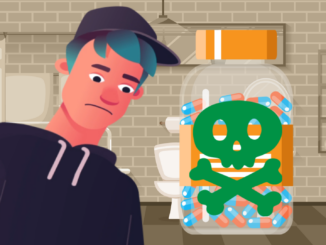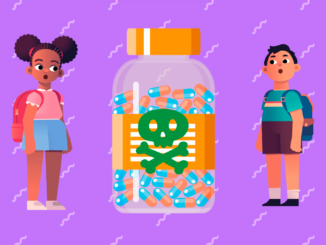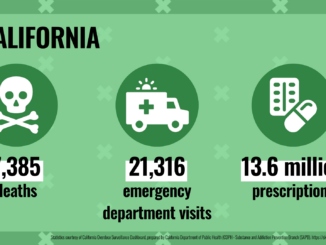
Safe disposal drug take-back bins keep drugs from abuse and out of the environment
by Anne Stokes
In the right hands, medications can work wonders. When mishandled, they can be the stuff of nightmares, setting the stage for addiction and overdose deaths, increased crime rates, and even pollution that not only affects fish and wildlife, but gets into drinking water supplies.
Since 2018, California has implemented statewide programs to divert unused medications out of homes and the environment. Safe disposal drug take-back bins provide residents with safe and easily accessible options to ensure medications are not stockpiled in medicine cabinets, flushed down the drain, or left to languish in landfills. Commonly located in pharmacies, these bins make it easy for people to safely get rid of old medications the same time they pick up new ones.
“We urge everyone to ensure they properly dispose of their unused drugs at designated sites to enhance public safety,” says Sacramento County Health Officer Dr. Olivia Kasirye.
“We urge everyone to ensure they properly dispose of their unused drugs at designated sites to enhance public safety.”
Olivia Kasirye, MD, MS, Sacramento County Health Officer
Intentional and unintentional misuse
Across the state in 2022, the California Overdose Surveillance Dashboard, prepared by California Department of Public Health, documented:
- 7,385 opioid-related overdose deaths
- 21,316 opioid overdose emergency room visits
- 13,640,794 opioid prescriptions
Unfortunately, these figures don’t just reflect adults. A national study conducted from 2009 to 2020 found nearly 678,000 children under the age of five ended up in the emergency room due to unsupervised medication exposure. A majority—67.4%—involved children under the age of two. Adolescents and teens experienced an extreme jump in overdose deaths—94%—between 2019 and 2020, according to the Centers for Disease Control and Prevention (CDC).
“One of our biggest problems is that kids are getting their hands on these medications. They go over to grandma and grandpa’s house where there are lots of medications and they’ll take some pills,” says Sgt. Brian Gunsolley with the Orange County Sheriff’s Department. “That’s really dangerous for teenagers: They can get addicted, they can overdose, they can go to a party and mix it with alcohol or other drugs and that can be fatal.”
During a drug take-back event in Orange County in October 2019, Gunsolley says that more than 3,000 pounds of medications were collected from 12 sheriff department-sponsored locations alone. While collecting more than 1.5 tons of pills is a good thing, stockpiling medications to wait for an annual event can be a recipe for misuse. Whether it’s family, friends, or burglars, medicine cabinets can be a magnet for those looking to abuse medications or sell them on the black market.
Polluting watersheds
While most people know that anything flushed down the drain ends up at a water treatment plant, most aren’t aware that the intricate processes involved in water cleaning aren’t geared toward removing medications.
“We have treatment processes that take out organic matter and then use microbes to digest those compounds. It reduces the organic matter in the water to a point where we can discharge it back to the river or stream,” says Brandon Nakagawa, Water Resource Coordinator with the San Joaquin County Department of Public Works. “Pharmaceuticals are something that our systems aren’t necessarily designed to remove.”
According to the Environmental Protection Agency, pharmaceuticals are increasingly being detected in drinking water. Even when found in minuscule amounts, the number of compounds that end up in the public’s drinking water, combined with long-term cumulative exposure to these compounds, becomes worrisome. Studies by the CDC found that even at very low levels of exposure, pharmaceutical compounds may affect physiological responses in humans, plants, and animals, and can lead to antibiotic-resistant bacteria in water. Medications that end up in landfills also pose a threat to municipal drinking water supplies.
“When you throw it in the trash, there’s a potential for contamination from this material,” Says Hans Kernkamp, general manager and chief engineer of the Riverside County Department of Waste Resources. “Taking it to the landfill—even though it’s lined and hopefully does a good job of preventing groundwater contamination—nobody can say that it’s 100 percent foolproof, so there’s always that possibility.”
A safe and convenient solution
Rather than risk misuse or pollution, pharmaceutical take-back bins provide safe and anonymous year-round options for residents to get rid of unused medications.
“Patients and their families are looking for a way to get rid of old medications, just to help simplify what they have at home and make sure that people who could be harmed by accidental ingestion don’t have access to them,” says Dr. Rais Vohra, Interim health officer with the Fresno County Department of Public Health. “Take-back programs allow people both an opportunity and a place to do that.”
To find a bin near you, go to medtakebackcalifornia.org.
Read more stories about med bins in California’s Central Valley, High Desert, Los Angeles/Ventura, North Central Valley, North Coast, Orange County, Rural Mountains, San Diego, South Central Valley.
Brought to you by the California Drug Take-Back Program and the California Product Stewardship Council.
Recent facebook posts from California Product Stewardship Council

The California Product Stewardship Council (CPSC) is a powerful network of local governments, non-government organizations, businesses, and individuals supporting policies and projects where producers share in the responsibility for managing problem products at their end of life.
CPSC is California’s thought leader and expert on Product Stewardship and the Extended Producer Responsibility (EPR) movement.
EPR enjoys the support of more than 26 million Californians. That’s nearly 70% of the state's population! Nearly 150 resolutions have been passed by California local jurisdictions and organizations supporting a more sustainable and toxic free environment through product stewardship. CPSC works closely with companies who have redesigned products for reuse as well as those who have established pilot or permanent collection programs with some sharing of costs with others in the product chain.
California Product Stewardship Council



